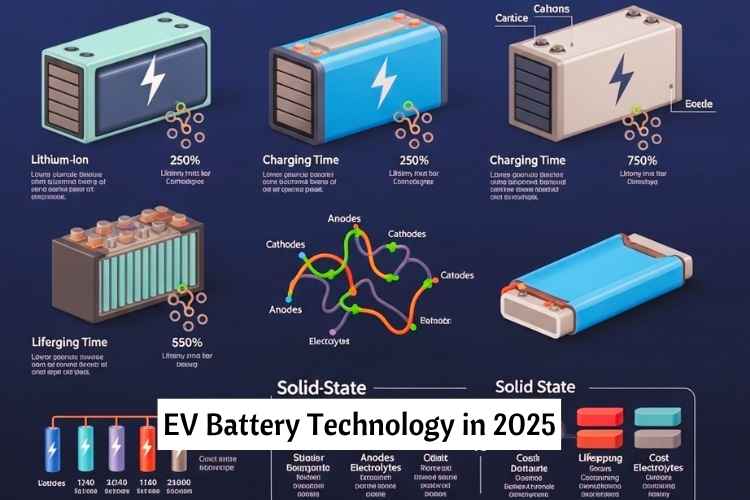EV Battery Technology in 2025: Electric vehicles (EVs) are no longer a vision of the future—they are the present, and their future is charging faster than ever. In 2025, EV battery technology is pivotal, with innovations reshaping how we drive, charge, and even think about transportation. Whether you’re a curious driver, a green energy enthusiast, or an industry stakeholder, understanding the evolving landscape of EV batteries in 2025 is crucial.
Let’s break it down.

Table of Contents
Why EV Battery Technology in 2025

At the heart of every electric vehicle is the battery. It determines:
- Range (how far you can drive on a single charge)
- Charging speed
- Lifespan
- Cost of the vehicle
- Environmental impact
With the global push toward net-zero emissions and governments offering incentives for clean energy, the demand for efficient, affordable, and sustainable EV battery solutions will be sky-high in 2025.
EV Battery Technology in 2025: The Current Landscape
| Battery Type | Key Features | Example Models | Estimated Range (2025) |
|---|---|---|---|
| Lithium-Ion (Li-ion) | High energy density, widely used, mature tech | Tesla Model 3, Hyundai Ioniq 5 | 250–400 miles |
| LFP (Lithium Iron Phosphate) | Cheaper, safer, slightly lower energy density | BYD Han, Tesla Model 3 (China variant) | 200–300 miles |
| NCM (Nickel Cobalt Manganese) | Higher energy, slightly costlier, common in premium EVs | Mercedes EQS, BMW i4 | 300–450 miles |
| Solid-State Batteries | Next-gen tech promises faster charge, longer life, non-flammable | Toyota concept EVs, QuantumScape prototypes | Next-gen tech promises faster charge, longer life, and non-flammable |
Key Stats on EV Batteries in 2025
| Metric | 2023 | 2025 (Projected) |
|---|---|---|
| Avg. EV Battery Cost per kWh | $139 | $100 or less |
| Fast Charging Time (80% capacity) | 30–40 minutes | 10–20 minutes |
| Global EV Battery Market Value | $50 billion | $95–105 billion |
| Solid-State Battery Adoption | <1% | 5–10% (early adopters) |
| Avg. Battery Lifecycle (cycles) | 1,000–1,500 cycles | 2,000+ cycles (with new tech) |
What’s Next for EV Battery Technology Beyond 2025?
| Trend | Expected Impact |
|---|---|
| Wireless Charging | Convenience for urban drivers; already in pilot programs in Norway and the US |
| Self-Healing Batteries | Increase longevity by repairing micro-cracks in electrodes |
| Vehicle-to-Grid (V2G) | Allows EVs to power homes and return energy to the grid |
| Battery-as-a-Service (BaaS) | Swappable battery tech is gaining traction in Asia, especially with NIO |
Conclusion
EV battery technology in 2025 is a thrilling blend of proven solutions and pioneering innovation. From solid-state breakthroughs to recycled battery ecosystems, we’re entering a new era where EVs are not just alternatives to gas-powered cars—they’re superior in many ways.
As costs drop, ranges increase, and charging becomes faster than ever, the only question left is: Are you ready to plug into the future?
Bhakti Rawat is a Founder & Writer of InsureMyCar360.com. This site Provides You with Information Related To the Best Auto Insurance Updates & comparisons. 🔗
